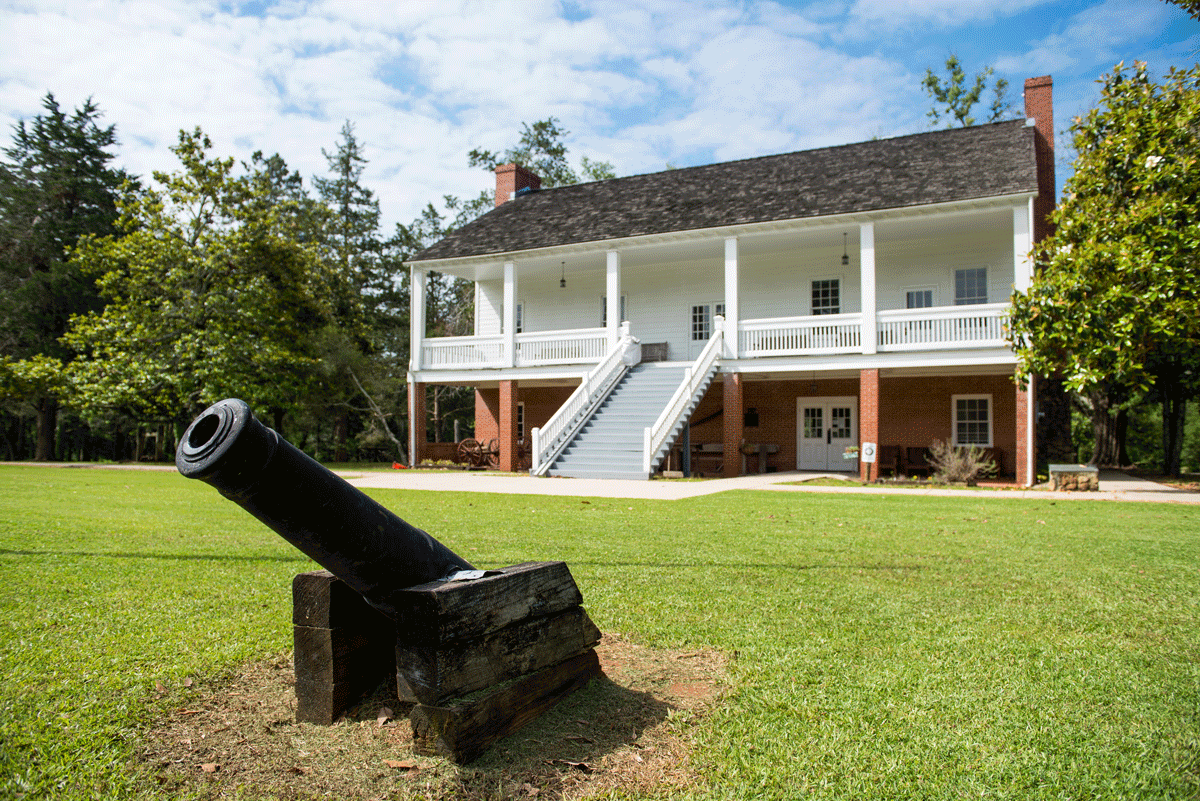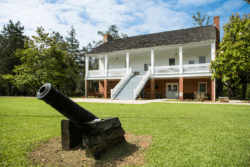No-Man’s Land
Fort Jesup remains a historic reminder of Louisiana’s time on the Mexican border
Published: December 1, 2024
Last Updated: February 28, 2025

Photo by Paul Kieu
Reconstructed Officers’ Quarters at Fort Jesup.
For a quarter century, now-obscure Fort Jesup, in far-west Louisiana near the Texas state line, was one of the most important military installations in what was then the western United States. For most of the eighteenth century, it hadn’t mattered exactly where the western border of Louisiana was. From 1714 until the French Revolution, France and Spain were ruled by cousins so friendly that when France whiffed the Seven Years’ War, it could throw Louisiana into Spain’s lap to keep it in the family. This arrangement worked well enough until Napoleon and the Saint-Domingue Revolution scrambled the political map, leaving Louisiana part of a young, expansionist United States facing the creaking Spanish Empire across a border that was . . . somewhere. Spain and the United States agreed on a stopgap neutral strip in 1806, an agreement that lasted until 1822—just in time for newly independent Mexico to emerge as Louisiana’s western neighbor.
After a treaty negotiated with Spain and inherited by Mexico, that strip of land passed into American hands. The government of the United States needed to impose order on the formerly freewheeling territory. Future president Zachary Taylor, a wealthy slaveholder who had achieved a degree of fame during the War of 1812, was on army-recruiting duty in Baton Rouge and had the side quest of fortifying the newish national border. In 1822 he moved the existing garrison near Natchitoches to the Fort Jesup site for its ability to control the watersheds of the Red and Sabine Rivers, naming it after Quartermaster General of the Army (and Taylor’s personal friend) Thomas Jesup. Manned by an “army of observation,” the fort, in addition to defending the United States–Mexico border, was central to the consolidation of authority over the former neutral strip. Meanwhile, the military built and improved infrastructure to encourage migration into the area. The nearby town of Many was founded in about 1837 and named for James B. Many, then the commander of the fort.
This once small fortification had become an epicenter of the United States’ most successful war to date.
From an American perspective, the army certainly needed to be observing. Mexico’s plan to open Texas to American settlers led to nine shaky years of national independence for the Republic of Texas beginning in 1836. The Mexican government, its hands full with other revolts, did not recognize the breakaway republic (while also arguing that even if Texas were independent, the border would be further north, not at the Rio Grande but at the Nueces River). A reconquest by Mexico, or least an attempt, seemed likely, and an anxious and nearly bankrupt Texas petitioned for annexation into the United States in 1845. Mexico, furious at American opportunism, severed diplomatic relationships with the United States. President Polk sent John Slidell, namesake of the Louisiana city, to Mexico City to negotiate the border of (now American) Texas and, while he was there, try to buy New Mexico and Upper California. Uninterested in selling half of their country, the Mexicans rebuffed Slidell. What might have been a border skirmish blossomed into a major war.
Both Taylor and Fort Jesup were central to the Mexican-American War. General Taylor was sent to fortify the mouth of the Rio Grande, and his force saw the first bloodshed of the war. Fort Jesup became one of the major mustering points for United States forces involved in the invasion of Mexico; of the seventy-three thousand American troops raised for the war, roughly half passed through Fort Jesup at some point. This once small fortification had become an epicenter of the United States’ most successful war to date.
The Mexican-American War marked the zenith of the fortunes of both Zachary Taylor and Fort Jesup, and Taylor was acclaimed as one of the heroes of the American victory. In 1848, nine months after the war ended, he was elected president of the United States; sixteen months into his term, he died, leaving the nation in the hands of Millard Fillmore. Fort Jesup’s star fell even faster; it was abandoned in 1846, before the Treaty of Guadalupe Hidalgo formally ended the war, but after American forces had succeeded well enough to ensure that the United States would retain Texas at the very least, making border control near the Sabine moot.
The US Army sold the site off to private buyers in 1869, and the fort was not maintained. The residents of Many, Louisiana, mobilized to preserve the fort in the 1930s; at that point, the only building left standing was a single barracks kitchen. Interested citizens restored this kitchen and established the surrounding area as a park. The site was designated a National Historic Landmark in 1961, and today a reconstructed officer’s house, built in consultation with army historians and the National Trust for Historic Preservation, serves as a museum of artifacts relevant to the site, interpreting the period of the fort’s heyday and presenting regular programming. (You may even walk in to find a park ranger making wool on a spinning wheel, as I once did.) Strictly speaking, the fort may be gone, but the history remains to remind us of Louisiana’s brief time as a border state.
Chris Turner-Neal is the former managing editor of 64 Parishes
